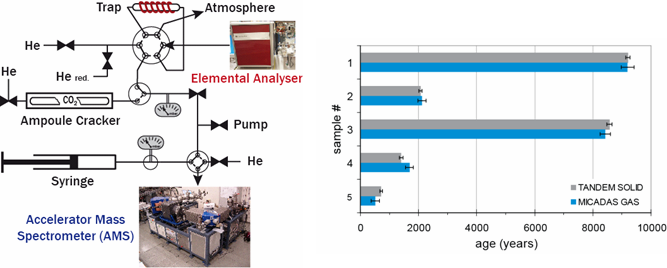|
Matthias Ruff1, Lukas Wacker2, Sönke Szidat1
1 Radiochemistry and Environmental Chemistry, University of Bern
2 Laboratory of Ion Beam Physics, ETH Zurich
Accelerator mass spectrometry (AMS) allows determination of radiocarbon (14C) in samples of milligram size for archeological and geological dating. Today AMS is a well established method which has replaced decay counting to a large extent. Two recent developments have improved the potential of AMS even further: a) the construction of small accelerator systems which fit into regular size laboratories and b) the installation of ion sources for direct measurement of carbon dioxide instead of solid graphite targets.
In collaboration with the ETH/PSI Laboratory of Ion Beam Physics, we equipped the worldwide smallest AMS system MICADA with a gas ion source. Firstly, a two-step method was established: carbon dioxide, which was formed by off-line combustion of solid samples, was supported in sealed ampoules (Ruff et al., Radiocarbon 49, 307-314, 2007). In the gas handling system, CO2 is released in an ampoule cracker, mixed with helium and then pressed continuously into the ion source at a constant flow rate using a syringe. This two-step method is now running for two years and ~400 samples have been measured yet. It enables 14C measurements of samples containing 2-40 µg carbon, which is ~2 orders of magnitude smaller than for routine AMS measurements at the ETH/PSI Laboratory.
For complete automation of the measurements, we now coupled the AMS system with an Elemental Analyzer (EA) for on-line combustion and 14C analysis of archeological and environmental samples. A first intercomparison of bone and charcoal samples is shown below. Within measurement uncertainties, the on-line system ("MICADA gas", sample weights <80 µg) and the routine dating procedure ("TANDEM solid", sample weights >2000 µg) gave consistent results.
See the website of the group of PD Dr. Sönke Szidat for more information.
|
